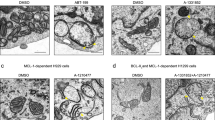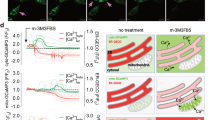Abstract
Thapsigargin (TG), by inducing perturbations in cellular Ca2+ homeostasis, can induce apoptosis, but the molecular mechanisms remain to be fully elucidated. We have recently reported that TG-induced apoptosis appears to involve the DR5-dependent apoptotic pathway that cross talks with the mitochondrial pathway via TG-induced Bid cleavage. In this study, we have utilized Bax-proficient and -deficient HCT116 human colon cancer cells to investigate the effect of Bax deficiency on TG-induced apoptosis and TG regulation of the DR5 and mitochondrial pathways. Our results indicate that Bax-deficient cells are less sensitive to undergo apoptosis following TG treatment. Our results further demonstrate that TG-induced apoptosis is coupled with DR5 upregulation and caspases 8 and 3 activation, as well as Bid cleavage in both Bax-proficient and -deficient cells, although caspase 3 activation was reduced in Bax-deficient cells. TG also promoted the release of cytochrome c into cytosol and caspase 9 activation in Bax-proficient cells but not in Bax-deficient cells. These findings suggest that although Bax is not absolutely required for death receptor (DR)-dependent signals, it appears to be a key molecule in TG-regulated mitochondrial events. Bax-deficient cells were relatively more resistant to Apo2L/TRAIL than the Bax-proficient counterparts. However, the combination of Apo2L/TRAIL and TG was more effective in mediating apoptosis in both Bax-proficient and -deficient cells and that was coupled with activation of caspases 8 and 3. Although both agents in combination also induced cytochrome c release into cytosol and caspase 9 activation in Bax-proficient cells, these events were abrogated in Bax-deficient cells. Our results thus suggest that the combination of Apo2L/TRAIL and TG appears to bypass the Bax deficiency-induced defects in the mitochondrial (intrinsic) pathway by engaging the DR5-dependent apoptotic signals (extrinsic pathway).
This is a preview of subscription content, access via your institution
Access options
Subscribe to this journal
Receive 50 print issues and online access
$259.00 per year
only $5.18 per issue
Buy this article
- Purchase on Springer Link
- Instant access to full article PDF
Prices may be subject to local taxes which are calculated during checkout






Similar content being viewed by others
References
Ashkenazi A, Pai RC, Fong S, Leung S, Lawrence DA, Marsters SA, Blackie C, Chang L, McMurtrey AE, Hebert A, DeForge L, Koumenis IL, Lewis D, Harris L, Bussiere J, Koepen H, Shahrokh Z and Schwall RH . (1999). J. Clin. Invest., 104, 155–162.
Boya P, Cohen I, Zamzami N, Vieira HLA and Kroemer G . (2002). Cell Death Differ., 9, 465–467.
Burns TF and El-Deiry WS . (2001). J. Biol. Chem., 276, 37879–37886.
Deng Y Lin Y and Wu X . (2002). Genes Dev., 16, 33–45.
Foyouzi-Youssefi R, Arnaudeau S, Broner C, Kelley WL, Tschopp J, Lew DP, Demaurex N and Krause KH . (2000). Proc. Natl. Acad. Sci. USA, 97, 5723–5728.
Furuya Y, Lundmo P, Short AD, Gill DL and Isaacs JT . (1994). Cancer Res., 54, 6167–6175.
He Q, Lee DI, Rong R, Yu M, Luo X, Klein M, El-Deiry WS, Huang Y, Hussain A and Sheikh MS . (2002a). Oncogene, 21, 2623–2633.
He Q, Luo X, Huang Y and Sheikh MS . (2002b). Oncogene, 21, 6032–6040.
Hsu YT, Wolter KG and Youle RJ . (1997). Proc. Natl. Acad. Sci. USA, 94, 3668–3672.
Huang Y, He Q, Rong R, Hillman MJ and Sheikh MS . (2001). Cancer Res., 61, 6918–6924.
Jin Z, Dicker DT and El-Deiry WS . (2002). Cell Cycle, 1, 82–89.
Johnstone RW, Ruefli AA and Lowe SW . (2002) Cell, 108, 153–164.
Kim BC, Kim HT, Mamura M, Ambudkar IS, Choi KS and Kim SJ . (2002). J. Biol. Chem., 277, 31381–31389.
Krebs J . (1998). BioMetals, 11, 375–382.
LeBlanc H, Lawrence D, Varfolomeev E, Totpal K, Morlan J, schow P, Fong S, Schwall R, Sinicropi D and Askenazi A . (2002). Nat. Med., 8, 274–281.
Mikhailov V, Mikhailova M, Degenhardt K, Venkatachalam MA, White E and Saikumar P . (2003). J. Biol. Chem., 278, 5367–5376.
Murphy AN, Bredesen E, Cortopassi G, Wang E and Fiskum G . (1996). Proc. Natl. Acad. Sci. USA, 93, 9893–9898.
Nechushtan A, Smith CL, Hsu YT and Youle RJ . (1999). EMBO J., 18, 2330–2341.
Nicholson DW . (2000). Nature, 407, 810–816.
Nutt LK, Chandra J, Pataer A, Fang B, Roth JA, Swisher SG, O'Neil RG and McConkey DJ . (2002a). J. Biol. Chem., 277, 20301–20308.
Nutt LK, Pataer A, Pahler J, Fang B, Roth JA, McConkey DJ and Swisher SG . (2002b). J. Biol. Chem., 277, 9219–9225.
Reed JC . (2002). Nat. Rev. Drug Dev., 1, 111–121.
Sagara Y and Inesi G . (1991). J. Biol. Chem., 266, 13503–13506.
Shimizu S, Eguchi Y, Kamiike W, Funahashi Y, Mignon A, Lacronique V, Matsuda H and Tsujimoto Y . (1998). Proc. Natl. Acad. Sci. USA, 95, 1455–1459.
Shimizu S, Narita M and Tsujimoto Y . (1999). Nature, 399, 483–487.
Tombal B, Denmeade SR, Gillis JM and Isaacs JT . (2002). Cell Death Differ., 9, 561–573.
Walczak H, Miller RE, Ariail K, Gliniak B, Griffith TS, Kubin M, Chin W, Jones J, Woodward A, Le T, Smith C, Smolak P, Goodwin RG, Rauch CT, Schuh JC and Lynch DH . (1999). Nat. Med., 5, 157–163
Wang X . (2001). Gene Dev., 15, 2922–2933.
Wertz IE and Dixit VM . (2000). J. Biol. Chem., 275, 11470–11477.
Wolter KG, Hsu YT, Smith CL, Nechushtan A, Xi XG and Youle RJ . (1997). J. Cell Biol., 139, 1281–1292.
Yang E and Korsmeyer SJ . (1996). Blood, 88, 368–401.
Zhang L, Yu J, Park BH, Kinzler KW and Vogelstein B . (2000). Science, 290, 989–992.
Acknowledgements
We thank Dr Avi Ashkenazi and Genentech for a generous supply of Apo2L/TRAIL and Dr Bert Vogelstein for kindly providing the Bax-proficient and -deficient HCT116 cells. This work was supported in part by United States Army Prostate Cancer Research Program grant DAMD 170010722 and by NIH Grant CA89043.
Author information
Authors and Affiliations
Corresponding author
Rights and permissions
About this article
Cite this article
He, Q., Montalbano, J., Corcoran, C. et al. Effect of Bax deficiency on death receptor 5 and mitochondrial pathways during endoplasmic reticulum calcium pool depletion-induced apoptosis. Oncogene 22, 2674–2679 (2003). https://doi.org/10.1038/sj.onc.1206363
Received:
Revised:
Accepted:
Published:
Issue Date:
DOI: https://doi.org/10.1038/sj.onc.1206363
Keywords
This article is cited by
-
Non-steroidal anti-inflammatory drugs induce immunogenic cell death in suppressing colorectal tumorigenesis
Oncogene (2021)
-
Caspase-3 feedback loop enhances Bid-induced AIF/endoG and Bak activation in Bax and p53-independent manner
Cell Death & Disease (2015)
-
Low dose IR-induced IGF-1-sCLU expression: a p53-repressed expression cascade that interferes with TGFβ1 signaling to confer a pro-survival bystander effect
Oncogene (2013)
-
Downregulation of Bid is associated with PKCɛ-mediated TRAIL resistance
Cell Death & Differentiation (2007)
-
Tetrandrine and thapsigargin release arachidonic acid from cells in culture and stimulate prostacyclin production in rat liver cells, but may do so by different pathways
BMC Pharmacology (2005)



